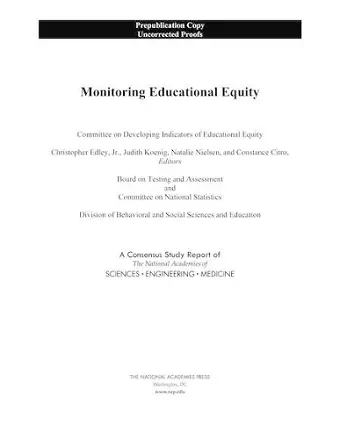Monitoring Educational Equity
Committee on National Statistics author Division of Behavioral and Social Sciences and Education author Board on Testing and Assessment author National Academies of Sciences, Engineering, and Medicine author Committee on Developing Indicators of Educational Equity author Natalie Nielsen editor Judith Koenig editor Constance Citro editor
Format:Paperback
Publisher:National Academies Press
Published:30th Oct '19
Currently unavailable, and unfortunately no date known when it will be back

Disparities in educational attainment among population groups have characterized the United States throughout its history. Education is sometimes characterized as the "great equalizer," but to date, the country has not found ways to successfully address the adverse effects of socioeconomic circumstances, prejudice, and discrimination that suppress performance for some groups.
To ensure that the pursuit of equity encompasses both the goals to which the nation aspires for its children and the mechanisms to attain those goals, a revised set of equity indicators is needed. Measures of educational equity often fail to account for the impact of the circumstances in which students live on their academic engagement, academic progress, and educational attainment. Some of the contextual factors that bear on learning include food and housing insecurity, exposure to violence, unsafe neighborhoods, adverse childhood experiences, and exposure to environmental toxins. Consequently, it is difficult to identify when intervention is necessary and how it should function. A revised set of equity indicators should highlight disparities, provide a way to explore potential causes, and point toward possible improvements.
Monitoring Educational Equity proposes a system of indicators of educational equity and presents recommendations for implementation. This report also serves as a framework to help policy makers better understand and combat inequity in the United States' education system. Disparities in educational opportunities reinforce, and often amplify, disparities in outcomes throughout people's lives. Thus, it is critical to ensure that all students receive comprehensive supports that level the playing field in order to improve the well-being of underrepresented individuals and the nation.
Table of Contents- Front Matter
- Summary
- 1 Why Indicators of Educational Equity Are Needed
- 2 Committee's Framework for Indicators of Educational Equity
- 3 Contextual Influences on Educational Outcomes: Families and Neighborhoods
- 4 Indicators of Disparities in Student Outcomes
- 5 Indicators of Disparities in Access to Educational Opportunities
- 6 Paths Forward: Recommendations
- References and Bibliography
- Appendix A: Review of Existing Data Systems
- Appendix B: Assessment of Relevant Publications
- Appendix C: Data and Methodological Opportunities and Challenges for Developing K12 Educational Equity Indicators
- Appendix D: Agendas for Public Sessions of the Committee
- Appendix E: Biographical Sketches of Committee Members and Staff
- Committee on National Statistics <
ISBN: 9780309490160
Dimensions: unknown
Weight: unknown
268 pages